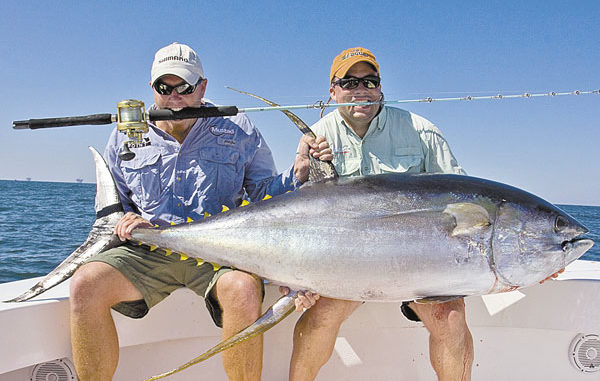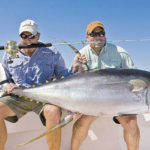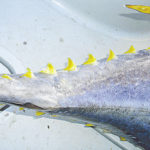
Popularity of this tuna among recreational fishing community growing.
Yellowfin tuna have become one of the more important recreational and commercial fish species in the open waters of the Gulf of Mexico. Their growth in popularity seemed to come from nowhere. For example, prior to 1985, there were no commercial landings for the species in the state as far back as records were kept. By 1988, commercial landings were over 12 million pounds.
Recreational fishing effort targeting tuna of any type was close to zero in the early 1980s as well, with only a few pioneering charter fishermen trying to tangle with them. Commercial landings have tapered off tremendously since the boom years of the 1980s, but recreational effort just seems to grow and grow.
Fifteen members of the tuna/mackerel family swim in the Gulf. Five of them are tuna proper, of the genus Thunnus — bluefin, blackfin, albacore, bigeye and our hero here, the yellowfin tuna, Thunnus albacares. The first part of their scientific name, Thunnus, is Greek in origin and simply means tunna or tuna. The origin of albacares is a mystery to me, but does not link the species to the albacore tuna, Thunnus alalunga.
From a physiological point of view, yellowfin tuna are one of the oddest fish in the sea. The phrase “cold as a fish” certainly doesn’t apply to them. They are actually warm-blooded, and can maintain an internal body temperature as much as 50 degrees above surrounding seawater. They do this by means of a network of veins and arteries called a “rete mirable,” that allows them to trap (and dump) heat generated by their metabolic processes.
This is a huge advantage. For most cold-blooded fish, the colder the water and, therefore, their body is, the slower and more sluggish they are. Tuna’s warmer body temperatures speed up the chemical reactions in their bodies that produce energy and allow their muscles to contract more quickly. This provides faster swimming speeds and increases their endurance.
Yellowfin tuna in the Pacific Ocean are often found on the edges of island coral reefs during the day. Each night they travel up to 9 miles offshore to feed and then return to the exact spot they started from. That’s the equivalent, in human terms, of walking 37 miles each night for supper.
Tagging studies on tunas in the open sea show similar behavior. A tuna will hang around a floating log or other debris during the day, travel long distances at night, and then return to the exact same log the next day.
Tunas are speed machines. Some fish are faster and some fish swim just as far as they do. But no fish swims as far as fast as tunas. They are built to overcome the tremendous resistance, or drag, of moving through water. Every eight-fold increase in swimming speed requires a 100-fold increase in energy expenditure.
Structures on tuna that reduce drag are caudal peduncle keels. These are the hard keels extending out from both sides of a tuna’s body just in front of the tail. They reduce water turbulence created by the tail fin and lower drag from that part of the body.
The small finlets located on the top and bottom of their bodies between their rearmost fins and their tails are thought to prevent water swirls from spinning off their bodies and tails, allowing the tail fin to work more efficiently in undisturbed water.
Their first dorsal (back) fin also folds down into a groove on the body to reduce drag when the fish does not need it to maneuver.
Not all of their modifications for speed are external. Compared to other less active fish, tunas have hearts that are 10 times larger for their body weight, pump three times as much blood and have blood pressure three times higher. They also have a much higher proportion of red muscle in their bodies than the average fish, which allows them to cruise at higher speeds more efficiently. They have been observed to swim at 28 mph for long distances.
Finally, they have gills that are up to 30 times larger in surface areas than other fish. And they cannot open and close their gill covers to force water over their gills. Flaring gill covers would create drag.
This means that tuna must swim or suffocate. They are “obligate ram ventilators,” and must constantly swim to force oxygen-bearing water over their gills.
Fortunately, considering the fishing pressure they are under, yellowfin tuna spawn like they swim. In spite of living many years, they begin spawning at age 2 to 3, and as long during the summer that water temperatures are above 78 degrees, they will spawn every day or two. A large female can lay up to 8 million eggs each time she spawns.
Yellowfins feed on a huge variety of fish species, especially mackerels, tuna, flying fish and dolphins. Some squid are eaten as well. They can even use the fine fingerlike extensions of their gill arches, called gill rakers, to strain tiny plankton from the water to supplement their diet.
They have excellent sight, but almost unbelievably, they can actually smell their underwater prey. When they scent the oils, proteins and amino acids from the slime of other fish, they will track them down.
Large yellowfin tuna have extended arch-shaped dorsal and anal fins that make them easy to identify. But small yellowfins can be difficult to separate from bigeye tuna. Both have yellow finlets. Albacores also have yellow finlets, but their huge pectoral (side) fins make them easy to ID. Bluefin and blackfin tuna have dark finlets. True to their name, bigeye tuna do have a larger eye, but it may take an experienced fisherman to spot the difference.
Jerald Horst is author of six books on fish and seafood, including the acclaimed Trout Masters: How Louisiana’s Best Anglers Catch the Lunkers. His latest book is Game Warden: On Patrol in Louisiana.




